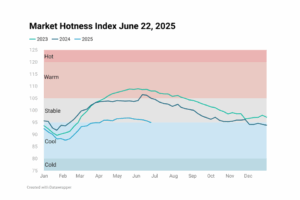Fed Maintains Current Interest Rates
The Federal Reserve held the federal funds rate steady at its May 2025 meeting, indicating that risks to both inflation and employment had increased amid uncertainty regarding the economic outlook due to the administration’s tariff policies. The Fed’s rate-setting committee or the Federal Open Market Committee (FOMC) voted unanimously to maintain the federal funds rate target range at its recent meeting despite calls to lower rates.
The FOMC consists of seven governors of the Federal Reserve Board and five Federal Reserve Bank presidents. This committee convenes eight times annually to assess economic conditions and formulate monetary policy.
In its policy statement, the FOMC acknowledged that the economy had maintained a consistent rate of expansion overall. The Committee attributed a decline in first-quarter output to elevated import levels, suggesting anticipatory purchasing by businesses and households prior to the implementation of new import tariffs. Furthermore, the FOMC’s statement described the labor market as robust and observed that inflation remained elevated.
Federal Reserve's Dual Mandate
The Fed has a dual mandate of price stability and maximum sustainable employment and noted that there were risks to both. Typically, the Federal Reserve adjusts interest rates to manage distinct economic challenges; it increases rates to curb inflation, while reductions stimulate a sluggish economy. However, the implementation of import tariffs presented a unique dilemma, as these tariffs are projected to simultaneously elevate prices and suppress economic growth due to decreased consumer spending. The Federal Reserve acknowledged the uncertainty surrounding the future direction of the economy, which consequently complicated their ability to determine the timing and extent of future interest rate reductions in 2025.
The Indirect Influence on Mortgage Rates
It’s important to understand that the Federal Reserve does not directly dictate interest rates for mortgages and other consumer loans. Instead, its monetary policy decisions influence the interest rates that retail banks ultimately charge their customers. Generally, when the Federal Reserve increases its benchmark federal funds rate, retail banks tend to follow suit by raising interest rates on various financial products. However, mortgage rates operate somewhat independently of the federal funds rate. Instead, they primarily track the yields of 10-year Treasury notes. These yields are determined by market demand for Treasury notes. Lower demand for these notes generally leads to higher interest rates, while strong demand can conversely push rates lower.
Mortgage Rates Stable, Purchase Demand Shows Resilience
As of May 8, 2025, mortgage rates stood at 6.76%, maintaining the same level as the preceding week, according to data from Freddie Mac®. This rate was 30 basis points lower than the corresponding period last year. Separately, the Mortgage Bankers Association (MBA) reported in their Weekly Mortgage Applications Survey for the week ending May 2, 2025, that conventional purchase application volume experienced a 9 percent increase compared to the previous year, despite ongoing economic uncertainties.
Future Rate Outlook and Affordability Concerns
The big question on everyone’s mind is whether mortgage rates will continue their downward trend throughout 2025. While a slight decrease is possible, a significant drop is not anticipated. Veros projects the average 30-year mortgage rate to settle around 6.6% by the close of 2025. Consequently, housing affordability is unlikely to see substantial improvement, as home prices are still expected to experience moderate growth, offsetting any marginal decline in borrowing costs.










